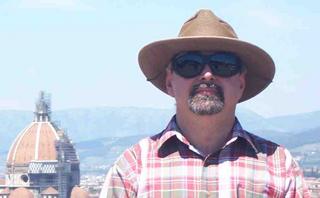My first visit to the Sistine Chapel happened in my callow youth. We were in Rome for five days and the visit was coming to an end. So I rushed over to the Vatican Museum, walked quickly through it, passed through the Sistine Chapel on the way out, pausing briefly to look up.

As the years went by, this memory bothered me more and more. So on my second visit, this time with my beloved, I took a book giving some details of the Chapel's frescoes and a small pair of binoculars. After a leisurely stroll through the Museum we moved over to a wall of the Sistine and waited patiently for a bench space to open up. We then sat for twenty minutes, trying to take it all in. I felt much better.
Until today, sigh:After hours at the Vatican Museums: "
There’s nothing quite like an evening book presentation inside the Vatican Museums. It’s a thrill just to walk through the darkened museum hallways at night, hours after the place has officially closed. Last Tuesday, there was the added spectacle of a thunderstorm raging outside. I headed to the conference hall, strolling past Egyptian mummies, Roman mosaics and rows of imperial busts that came to life with each flash of lightning. It felt like the opening of ‘The Da Vinci Code.’
The book presentation took place under the watchful eye of Augustus in armor on one side and a nude satyr on the other. As I settled in for the inevitable round of speeches, the question occurred to me: Who needs another book on the Sistine Chapel? This one was written by a German Jesuit, Father Heinrich Pfeiffer, who spent nearly 50 years investigating the religious images and symbols of the Sistine frescoes. His thesis turned out to be interesting, though: while modern experts tend to focus on the artistic vision and style of the chapel’s painters, including Michelangelo, the artists actually worked according to quite specific parameters set by papal theologians. As a result, Father Pfeiffer says, the chapel is really a study in Renaissance Christian iconography.
The bonus postscript to the speechifying was a private visit to the Sistine Chapel. As we all stood around craning our necks, Bruno Bartoloni, the longtime Vatican correspondent for Agence France-Presse and Corriere della Sera, took me aside and pointed to a spot halfway up the wall. There, camouflaged in a fresco of drapes, was a rectangular ‘peephole’ used by popes who wanted to watch over liturgies without being seen. Bartoloni, who has visited nearly every square inch of the Vatican’s jumbled geography, said he’d once stood inside the tiny papal hideaway.
It was still raining the next day when I returned to the Sistine Chapel during tourist rush hour. I wanted to see how the Vatican was handling the increasingly huge crowds that pour into the museum. The Sistine, of course, was shoulder-to-shoulder. A U.S. couple told me they had waited an hour and a half in line just to get into the museum; now, standing beneath one of the world’s artistic masterpieces, they felt like they were riding a crowded Roman bus. I don’t think they caught many of the frescoes’ iconographical details.
 Back home, they might want to check out Father Pfeiffer’s book, ‘The Sistine Chapel: A New Vision.’ And those who can’t afford the volume’s high price tag can always view parts of the chapel online at the Vatican’s Web site.
Back home, they might want to check out Father Pfeiffer’s book, ‘The Sistine Chapel: A New Vision.’ And those who can’t afford the volume’s high price tag can always view parts of the chapel online at the Vatican’s Web site.
(Via New Advent World Watch.)










No comments:
Post a Comment